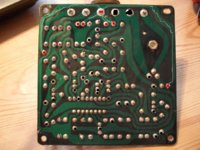Brett
XS650 Enthusiast
(1980 XS650 with TCI)
I haven't been able to start my bike since rebuilding it with new wiring.
I think I've narrowed it down to a fault with the TCI ignition box.
http://www.xs650.com/forum/showthread.php?t=21347&highlight=resistance+tci
At the ignition unit, I'm getting a resistance reading of 74.6 Ohms (on the 200 setting on my multimeter) between the ground (black) and +12v (red/white) wires and I don't think it should show anything. I assume this means there is a leak between live and ground somewhere on the circuit board.
If anyone has access to a spare Ignition unit or can easily access their unit on their bike, could they test the resistance between these two wires? (I assume it should show infinity ie no reading - but I could be wrong, it which case my ignition unit is ok) If I know I'm on the right track with solving this problem I can try and fix the PCB and FINALLY get the bike running.
Thanks in advance, it would be a great help.
Attached is a pic of my PCB, it looks fine to me.
I haven't been able to start my bike since rebuilding it with new wiring.
I think I've narrowed it down to a fault with the TCI ignition box.
http://www.xs650.com/forum/showthread.php?t=21347&highlight=resistance+tci
At the ignition unit, I'm getting a resistance reading of 74.6 Ohms (on the 200 setting on my multimeter) between the ground (black) and +12v (red/white) wires and I don't think it should show anything. I assume this means there is a leak between live and ground somewhere on the circuit board.
If anyone has access to a spare Ignition unit or can easily access their unit on their bike, could they test the resistance between these two wires? (I assume it should show infinity ie no reading - but I could be wrong, it which case my ignition unit is ok) If I know I'm on the right track with solving this problem I can try and fix the PCB and FINALLY get the bike running.
Thanks in advance, it would be a great help.
Attached is a pic of my PCB, it looks fine to me.



